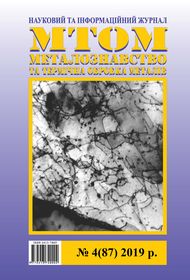Service life increasing of cold saws by heat treatment
DOI:
https://doi.org/10.30838/J.PMHTM.2413.241219.10.595Keywords:
cold saw, heat treatment, service life, ''scorin'' defect, ''cut'' defect, hardness, quenchingAbstract
Purpose of the study. To determine the possibility of increasing of service durability of cold saws by heat treatment of saw’s teeth. Develop the optimal heat treatment modes in order to obtain the higher service durability of cold saws. Develop the optimal heat treatment mode into industrial practice of cold saws’ treatment. Methodology. Investigation of the structure of cold saws has been carried out using light microscopes Neophot 32 and Axiovert 200M MAT with AxioVision 4.6.3 software. The hardness of cold saw’s teeth has been assessed by Vickers method. Microhardness has been determined by PMT-3 test equipment. Results. The experimental cold saws have been treated by 5 different modes. Two modes of heat treatment have been acknowledged as promising for industrial practice. Technology of cold saw’s teeth heat treatment has been developed. The technology let to increase the service durability of cold saws up to 2,58 times, compared to non heat treated cold saws. Scientific novelty. It has been found that hardness of martensitic and wide of semimartensitic zones mainly determine the service durability of cold saws and decreasing of “scoring” and “cuts” defects number during cutting process. Experimental results evidently prove that hardness of martensitic zone and width of transition zone determine the service durability of cold saws. Initial hardness of the steel had lesser impact on service durability of cold saws. Practical significance. The developed technology leads to increasing of service durability of cold saws. The technology lets to obtain the hardness of the tooth surface up to 62 HRC and wide semimartensitic zone. Developed technology leads to increasing of service durability cold saws in 2,58 times (2,5 shifts) compared with non treated cold saws.
References
Ishenko A.A. and Loza O.A. Pily goryachej rezki prokata. Konstrukcii i raschet [Hot rolled saws. Designs and calculation]. Mariupol : State Higher EducationalInstitutionPriazovStateTechnicalUniversity, 2012, 251 p. (in Russian).
Bannikov A.I. Sovershenstvovaniye protsessa rezaniya goryachego metalloprokata diskovymi pilami na osnove upravleniya teplofizicheskimi yavleniyami v kontaktnoy zone : diss. dokt. tehn. nauk : 05.02.07 [Improving the process of cutting hot metal by circular saws based on the control of thermophysical phenomena in the contact zone : Dissertation of the doctor of technical sciences: 05.02.07].Volgograd,VolgogradStateTechnicalUniversity, 2018, 306 p. (in Russian).
Bolshakov V.I., Volchuk V.M. and Dubrov Yu.I. Shlyakhy vidstezhuvannya transformatsiy mikrostruktury materialu, yaki vidbuvayutʹsya vnaslidok yoho znos [Ways of tracing the transformations of the microstructure of a material due to its wear]. Shostyy mizhnarodnyy sympozium ukrayinsʹkykh inzheneriv-mekhanikiv u Lʹvovi [Sixth International Symposium of Ukrainian Mechanical Engineers in Lviv]. Lviv : KINPATRI LTD, 2003, pp. 145–146. (in Ukrainian).
Ekobory T. Fizika i mekhanika razrusheniya i prochnost' tverdykh tel [Physics and mechanics of fracture and the strength of solids].Moscow: Metallurgy, 1971, pp. 141–149. (in Russian).
Loza O.A. Otsenka napryazhennoho sostoyanyya dyskov pyl horyachey rezky prokata [Assessment of the stress state of the saw blades for hot cutting]. Visnyk Pryazovsʹkoho derzhavnoho tekhnichnoho universytetu [Bulletin of the Priazovsky State Power Technical University]. 2012, issue 25, pp. 34–40. (in Russian).
Nasad T.G. Vysokoskorostnaya obrabotka s teplovym vozdeystviyem [High-speed heat treatment]. Saratov : Saratov State Technical University, 2007, 108 p. (in Russian).
Downloads
Published
Issue
Section
License
Authors that are published in this journal agree to follow the conditions:
Authors reserve the right to the authorship of his work and cede the right to the journal of first publication of this work on conditions of the license under the Creative Commons Attribution License, which allows others to distribute it freely with the obligatory reference to the author of the original work and the first publication of the work in this journal.

